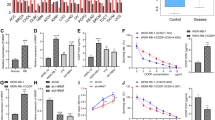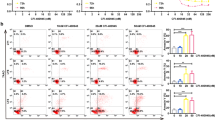Abstract
In the acute promyelocytic leukemia cell line, NB4, activation of the CD44 receptor triggers apoptosis. This pathway does not operate in the retinoid-maturation-resistant NB4-LR1 subclone. In this work, we show that the CD44 gene is silenced in these cells. The molecular defect involves DNA methylation of cytosine phosphate guanine (CpG) island and underacetylation of histone H3 at CD44 promoter. The methylating inhibitor 5-aza-CdR and cyclic AMP (cAMP) reverse the CD44 gene silencing. Contrary to 5-aza-CdR, cAMP does not induce DNA demethylation or histone modification at the CD44 promoter, whereas an H3pS10/AcK14 dual modification is observed on a global level. cAMP also induces the expression of c-Jun transcription factor and its recruitment at the CD44 promoter. Chromatin immunoprecipitation assays further show the association of brahma (Brm), a subunit of SWI/SNF chromatin-remodelling complex involved in the crosstalk between transcription and RNA polymerase II (RNA Pol II) processing, as well as the binding of phosphorylated RNA Pol II to the proximal promoter region of CD44. Finally, our study reveals that cAMP re-establishes the CD44-mediated cell death signalling. We propose that one of the actions of cAMP in restoring normal cell phenotype of leukaemia cells may consist in a broad trans-reactivation of silenced genes, despite marked hypermethylation of their promoters, as illustrated here with CD44 re-expression.
This is a preview of subscription content, access via your institution
Access options
Subscribe to this journal
Receive 12 print issues and online access
$259.00 per year
only $21.58 per issue
Buy this article
- Purchase on Springer Link
- Instant access to full article PDF
Prices may be subject to local taxes which are calculated during checkout







Similar content being viewed by others
References
Screaton GR, Bell MV, Jackson DG, Cornelis FB, Gerth U, Bell JI . Genomic structure of DNA encoding the lymphocyte homing receptor CD44 reveals at least 12 alternatively spliced exons. Proc Natl Acad Sci USA 1992; 89: 12160–12164.
Ghaffari S, Smadja-Joffe F, Oostendorp R, Levesque JP, Dougherty G, Eaves A et al. CD44 isoforms in normal and leukemic hematopoiesis. Exp Hematol 1999; 27: 978–993.
Lesley J, Hyman R, Kincade PW . CD44 and its interaction with extracellular matrix. Adv Immunol 1993; 54: 271–335.
Herrlich P, Morrison H, Sleeman J, Orian-Rousseau V, Konig H, Weg-Remers S et al. CD44 acts both as a growth- and invasiveness-promoting molecule and as a tumor-suppressing cofactor. Ann NY Acad Sci 2000; 910: 106–118; discussion 118–120.
Naor D, Nedvetzki S, Golan I, Melnik L, Faitelson Y . CD44 in cancer. Crit Rev Clin Lab Sci 2002; 39: 527–579.
Ponta H, Sherman L, Herrlich PA . CD44: from adhesion molecules to signalling regulators. Nat Rev Mol Cell Biol 2003; 4: 33–45.
Charrad RS, Li Y, Delpech B, Balitrand N, Clay D, Jasmin C et al. Ligation of the CD44 adhesion molecule reverses blockage of differentiation in human acute myeloid leukemia. Nat Med 1999; 5: 669–676.
Charrad RS, Gadhoum Z, Qi J, Glachant A, Allouche M, Jasmin C et al. Effects of anti-CD44 monoclonal antibodies on differentiation and apoptosis of human myeloid leukemia cell lines. Blood 2002; 99: 290–299.
Lanotte M, Martin-Thouvenin V, Najman S, Balerini P, Valensi F, Berger R . NB4, a maturation inducible cell line with t(15;17) marker isolated from a human acute promyelocytic leukemia (M3). Blood 1991; 77: 1080–1086.
Allouche M, Charrad RS, Bettaieb A, Greenland C, Grignon C, Smadja-Joffe F . Ligation of the CD44 adhesion molecule inhibits drug-induced apoptosis in human myeloid leukemia cells. Blood 2000; 96: 1187–1190.
Gadhoum Z, Leibovitch MP, Qi J, Dumenil D, Durand L, Leibovitch S et al. CD44: a new means to inhibit acute myeloid leukemia cell proliferation via p27Kip1. Blood 2004; 103: 1059–1068.
Gallagher RE . Retinoic acid resistance in acute promyelocytic leukemia. Leukemia 2002; 16: 1940–1958.
Melnick A, Licht JD . Deconstructing a disease: RARalpha, its fusion partners, and their roles in the pathogenesis of acute promyelocytic leukemia. Blood 1999; 93: 3167–3215.
Benoit G, Roussel M, Pendino F, Segal-Bendirdjian E, Lanotte M . Orchestration of multiple arrays of signal cross-talk and combinatorial interactions for maturation and cell death: another vision of t(15;17) preleukemic blast and APL-cell maturation. Oncogene 2001; 20: 7161–7177.
Ruchaud S, Duprez E, Gendron MC, Houge G, Genieser HG, Jastorff B et al. Two distinctly regulated events, priming and triggering, during retinoid-induced maturation and resistance of NB4 promyelocytic leukemia cell line. Proc Natl Acad Sci USA 1994; 91: 8428–8432.
Roussel MJ, Lanotte M . Maturation sensitive and resistant t(15;17) NB4 cell lines as tools for APL physiopathology: nomenclature of cells and repertory of their known genetic alterations and phenotypes. Oncogene 2001; 20: 7287–7291.
Duprez E, Lillehaug JR, Naoe T, Lanotte M . cAMP signalling is decisive for recovery of nuclear bodies (PODs) during maturation of RA-resistant t(15;17) promyelocytic leukemia NB4 cells expressing PML-RAR alpha. Oncogene 1996; 12: 2451–2459.
Zhu Q, Zhang JW, Zhu HQ, Shen YL, Flexor M, Jia PM et al. Synergic effects of arsenic trioxide and cAMP during acute promyelocytic leukemia cell maturation subtends a novel signaling cross-talk. Blood 2002; 99: 1014–1022.
Boisvert FM, Kruhlak MJ, Box AK, Hendzel MJ, Bazett-Jones DP . The transcription coactivator CBP is a dynamic component of the promyelocytic leukemia nuclear body. J Cell Biol 2001; 152: 1099–1106.
Parrella E, Gianni M, Cecconi V, Nigro E, Barzago MM, Rambaldi A et al. Phosphodiesterase IV inhibition by piclamilast potentiates the cytodifferentiating action of retinoids in myeloid leukemia cells. Cross-talk between the cAMP and the retinoic acid signaling pathways. J Biol Chem 2004; 279: 42026–42040.
Kamashev D, Vitoux D, De The H . PML-RARA-RXR oligomers mediate retinoid and rexinoid/cAMP cross-talk in acute promyelocytic leukemia cell differentiation. J Exp Med 2004; 199: 1163–1174.
Razin A . CpG methylation, chromatin structure and gene silencing-a three-way connection. EMBO J 1998; 17: 4905–4908.
Baker EK, El-Osta A . The rise of DNA methylation and the importance of chromatin on multidrug resistance in cancer. Exp Cell Res 2003; 290: 177–194.
Yamada Y, Watanabe H, Miura F, Soejima H, Uchiyama M, Iwasaka T et al. A comprehensive analysis of allelic methylation status of CpG islands on human chromosome 21q. Genome Res 2004; 14: 247–266.
Maquarre E, Artus C, Gadhoum Z, Jasmin C, Smadja-Joffe F, Robert-Lezenes J . CD44 ligation induces apoptosis via caspase- and serine protease-dependent pathways in acute promyelocytic leukemia cells. Leukemia 2005; 19: 2296–2303.
Shtivelman E, Bishop JM . Expression of CD44 is repressed in neuroblastoma cells. Mol Cell Biol 1991; 11: 5446–5453.
Gardiner-Garden M, Frommer M . CpG islands in vertebrate genomes. J Mol Biol 1987; 196: 261–282.
Berger SL . Histone modifications in transcriptional regulation. Curr Opin Genet Dev 2002; 12: 142–148.
Eberharter A, Becker PB . Histone acetylation: a switch between repressive and permissive chromatin. Second in review series on chromatin dynamics. EMBO Rep 2002; 3: 224–229.
Grunstein M . Histone acetylation in chromatin structure and transcription. Nature 1997; 389: 349–352.
Benoit G, Altucci L, Flexor M, Ruchaud S, Lillehaug J, Raffelsberger W et al. RAR-independent RXR signaling induces t(15;17) leukemia cell maturation. EMBO J 1999; 18: 7011–7018.
Fischle W, Wang Y, Allis CD . Histone and chromatin cross-talk. Curr Opin Cell Biol 2003; 15: 172–183.
Peterson CL, Laniel MA . Histones and histone modifications. Curr Biol 2004; 14: R546–R551.
Strahl BD, Allis CD . The language of covalent histone modifications. Nature 2000; 403: 41–45.
Cheung P, Tanner KG, Cheung WL, Sassone-Corsi P, Denu JM, Allis CD . Synergistic coupling of histone H3 phosphorylation and acetylation in response to epidermal growth factor stimulation. Mol Cell 2000; 5: 905–915.
Lo WS, Trievel RC, Rojas JR, Duggan L, Hsu JY, Allis CD et al. Phosphorylation of serine 10 in histone H3 is functionally linked in vitro and in vivo to Gcn5-mediated acetylation at lysine 14. Mol Cell 2000; 5: 917–926.
Nowak SJ, Corces VG . Phosphorylation of histone H3 correlates with transcriptionally active loci. Genes Dev 2000; 14: 3003–3013.
Lachner M, O'Carroll D, Rea S, Mechtler K, Jenuwein T . Methylation of histone H3 lysine 9 creates a binding site for HP1 proteins. Nature 2001; 410: 116–120.
Nakayama J, Rice JC, Strahl BD, Allis CD, Grewal SI . Role of histone H3 lysine 9 methylation in epigenetic control of heterochromatin assembly. Science 2001; 292: 110–113.
Zhang Y, Reinberg D . Transcription regulation by histone methylation: interplay between different covalent modifications of the core histone tails. Genes Dev 2001; 15: 2343–2360.
Kouzarides T . Histone methylation in transcriptional control. Curr Opin Genet Dev 2002; 12: 198–209.
Zambon AC, Zhang L, Minovitsky S, Kanter JR, Prabhakar S, Salomonis N et al. Gene expression patterns define key transcriptional events in cell-cycle regulation by cAMP and protein kinase A. Proc Natl Acad Sci USA 2005; 102: 8561–8566.
Li J, Guo Y, Schroeder FA, Youngs RM, Schmidt TW, Ferris C et al. Dopamine D2-like antagonists induce chromatin remodeling in striatal neurons through cyclic AMP-protein kinase A and NMDA receptor signaling. J Neurochem 2004; 90: 1117–1131.
Salvador LM, Park Y, Cottom J, Maizels ET, Jones JC, Schillace RV et al. Follicle-stimulating hormone stimulates protein kinase A-mediated histone H3 phosphorylation and acetylation leading to select gene activation in ovarian granulosa cells. J Biol Chem 2001; 276: 40146–40155.
Hyman R . Lack of a consistent relationship between demethylation of the CD44 promoter and CD44 expression. Immunogenetics 2002; 53: 914–924.
Banine F, Bartlett C, Gunawardena R, Muchardt C, Yaniv M, Knudsen ES et al. SWI/SNF chromatin-remodelling factors induce changes in DNA methylation to promote transcriptional activation. Cancer Res 2005; 65: 3542–3547.
Batsché E, Yaniv M, Muchardt C . The human SWI/SNF subunit Brm is a regulator of alternative splicing. Nat Struct Mol Biol 2006; 13: 22–29.
Schmits R, Filmus J, Gerwin N, Senaldi G, Kiefer F, Kundig T et al. CD44 regulates hematopoietic progenitor distribution, granuloma formation, and tumorigenicity. Blood 1997; 90: 2217–2233.
Rochette-Egly C . Dynamic combinatorial networks in nuclear receptor-mediated transcription. J Biol Chem 2005; 280: 32565–32568.
Gianni M, Terao M, Norio P, Barbui T, Rambaldi A, Garattini E . All-trans retinoic acid and cyclic adenosine monophosphate cooperate in the expression of leukocyte alkaline phosphatase in acute promyelocytic leukemia cells. Blood 1995; 85: 3619–3635.
Kim J, Jia L, Stallcup MR, Coetzee GA . The role of protein kinase A pathway and cAMP responsive element-binding protein in androgen receptor-mediated transcription at the prostate-specific antigen locus. J Mol Endocrinol 2005; 34: 107–118.
Doucas V, Tini M, Egan DA, Evans RM . Modulation of CREB binding protein function by the promyelocytic (PML) oncoprotein suggests a role for nuclear bodies in hormone signaling. Proc Natl Acad Sci USA 1999; 96: 2627–2632.
Acknowledgements
We are grateful to Monica Pettersson (Biotage BA, Sweden) for pyrosequencing assays. We thank Niclas Setterblad and Frederic Brau for performing confocal microscopy analysis (Service d’Imagerie Cellulaire, IUH, Hôpital Saint-Louis). This work was supported by grants from ‘Ligue Nationale contre le Cancer’, ‘Association pour la Recherche contre le Cancer’, ‘Fondation pour la Recherche Médicale’ and ‘Fondation de France’. I Abecassis received fellowships from MRT, ‘Association pour la Recherche contre le Cancer’ (ARC) and ‘Société Française d’Hématologie’.
Author information
Authors and Affiliations
Corresponding author
Rights and permissions
About this article
Cite this article
Abecassis, I., Maes, J., Carrier, JL. et al. Re-expression of DNA methylation-silenced CD44 gene in a resistant NB4 cell line: rescue of CD44-dependent cell death by cAMP. Leukemia 22, 511–520 (2008). https://doi.org/10.1038/sj.leu.2405071
Received:
Revised:
Accepted:
Published:
Issue Date:
DOI: https://doi.org/10.1038/sj.leu.2405071
Keywords
This article is cited by
-
A high-throughput real-time PCR tissue-of-origin test to distinguish blood from lymphoblastoid cell line DNA for (epi)genomic studies
Scientific Reports (2022)
-
The biology and role of CD44 in cancer progression: therapeutic implications
Journal of Hematology & Oncology (2018)
-
FIBP knockdown attenuates growth and enhances chemotherapy in colorectal cancer via regulating GSK3β-related pathways
Oncogenesis (2018)
-
CD44 in hematological neoplasias
Annals of Hematology (2011)
-
Epigenetic regulation of CD44in Hodgkin and non-Hodgkin lymphoma
BMC Cancer (2010)



